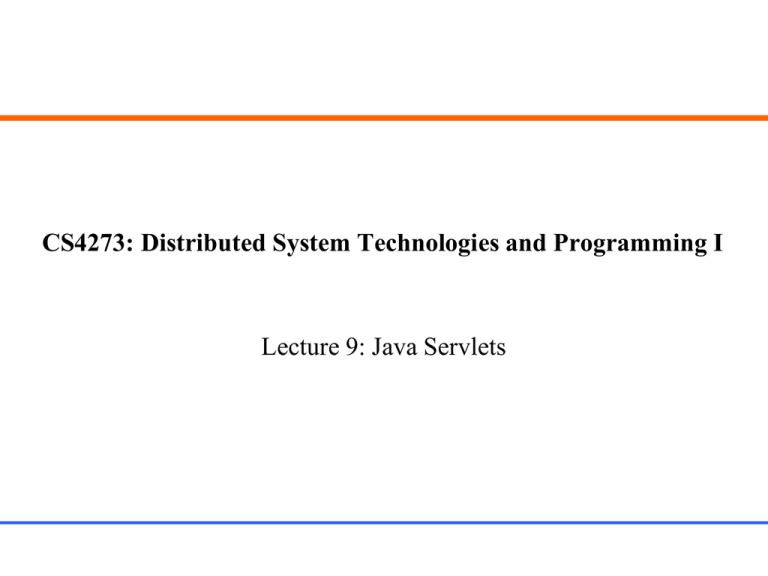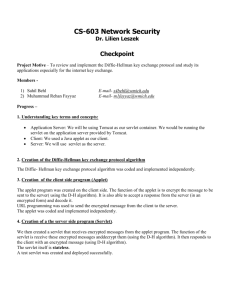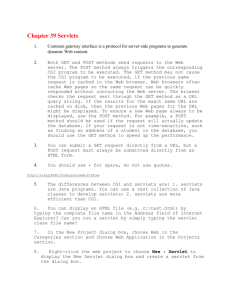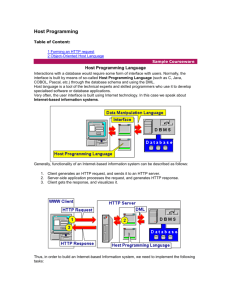CS4273: Distributed System Technologies and Programming I Lecture 9: Java Servlets
advertisement

CS4273: Distributed System Technologies and Programming I
Lecture 9: Java Servlets
CSlab Setting of Java Servlet
Servlet Engine searches files in directory “/usr/local/jt/webapps”. To facilitate access to
each person’s files, CSlab has made a link:
ln -s /home/lec/jia/www/java/js /usr/local/jt/webapps/jia
“/usr/jt/webapps/jia/” “~jia/www/java/js/”
1.
•
•
2.
3.
The servlet engine searches files relative from directory: /usr/local/jt/webapps/
http://jserv.cs.cityu.edu.hk:8080/jia/servlet/XXX is mapped to:
“~jia/www/java/js/” + “WEB-INF/classes/” + XXX, because:
http://jserv.cs.cityu.edu.hk:8080/jia /usr/local/jt/webapps/jia ~jia/www/java/js/
servlet /WEB-INF/classes
All servlet *.class files MUST be in directory:
~jia/www/java/js/WEB-INF/classes/
The corresponding URL is:
http://jserv.cs.cityu.edu.hk:8080/jia/servlet/GetServlet
All .html files MUST be in directory:
~jia/www/java/js/html/
The corresponding URL is:
http://jserv.cs.cityu.edu.hk:8080/jia/html/test.html
2
Your personal directory setting
1.
2.
3.
4.
CSlab already made a link from /usr/jt/webapps/501234 to your personal directory
“~501234/www/java/js” in CSlab account (501234 is your student number).
A copy of all sample programs is in /public/cs4273.tar (zipped at ~jia/www). You can
un-zip all files into your directory “~501234/www/” by UNIX commands:
cd www
// change dir to
tar –xvf /public/cs4273.tar
// un-zip files into “~501234/www/java/js”
All files are in directories “www/java/js/WEB-INF/classes/”, “www/java/js/html/”.
To run servlet in “~501234/www/java/js/WEB-INF/classes/GetServlet.class”, URL is:
http://jserv.cs.cityu.edu.hk:8080/501234/servlet/GetServlet
To run a servlet by a html file in “~501234/www/java/js/html/test.html”, URL is:
http://jserv.cs.cityu.edu.hk:8080/501234/html/test.html
Note: 1) servEngine cannot detect any change of your program until it restarts. In current
setting, servEngine auto-restarts every 20 min. Wait for about 20 min to refresh a page.
2) For each servlet, you need to add a new item in file …/js/WEB-INF/web.xml
3
Java Servlet
• Servlet runs on the web site. To enable servlets, it needs to
install a servlet engine (e.g., Jserv, or Tomcat), which is a
module of a web-server and runs inside the web-server process.
• Servlet replaces CGI program to link clients (in browser) to
back-end servers. Servlet generates HTML pages, sent back to
browser for display, similar to ASP.
• Servlet can support many protocols of request / response type,
such as HTTP, URL, FTP, SMTP. That’s, any requests coming
in the form of these protocols can be processed by a servlet
(Servlet API defines the support of these protocols).
• The most common protocol that Servlet supports is HTTP.
4
Servlet Life Cycle
Servlets run on the web server as part of the web-server process. The
web-server initializes, invokes and destroys servlet instances. It
invokes servlets via Servlet interface, consisting of three methods:
• init(). It is called only once, when the servlet is first loaded. It is
guaranteed to finish before any other calls are made to the servlet.
• service(). Each request from a client results in a single call to this
method. It receives (from the web server) a ServletRequest object
& a ServletResponse object to get request / send reply to clients.
• destroy(). It is called to allow your servlet to clean up any
resources. Most of the time, it is an empty method.
5
A Simple Servlet
http://jserv...hk:8080/jia/servlet/GenericServlet
import javax.servlet.*;
public class GenericServlet implements Servlet{
private ServletConfig config;
public void init (ServletConfig config)
throws ServletException {
this.config = config;
}
public void destroy() {} // do nothing
public ServletConfig getServletConfig() {
return config;
}
public String getServletInfo() {
return “A Simple Servlet”;
}
public void service (ServletRequest req,
ServletResponse res)
throws ServletException, IOException {
res.setContentType( “text/html” );
PrintWriter out = res.getWriter();
out.println( “<html>” );
out.println( “<head>” );
out.println( “<title>A Simple Servlet</title>” );
out.println( “</head>” );
out.println( “<body>” );
out.println( “<h1>Hello Servlet</h1>” );
…………
out.close();
}
}
6
Http Servlet
The servlet package has two abstract classes that implement interface Servlet:
GenericServlet from package javax.servlet
HttpServlet from package javax.servlet.http
• HttpServlet overrides the key method service() by adding the code to
distinguish HTTP requests and invokes corresponding methods:
–
–
–
–
–
–
doPost()
doGet()
doHead()
doDelete()
doOption()
doTrace()
• Most of programs extend class HttpServlet, and implement methods
doPost() and doGet().
7
Example of an HTTP servlet
import javax.servlet.*;
import javax.servlet.http.*;
public class GetServlet extends HttpServlet {
public void doGet(HttpServletRequest request,
HttpServletResponse response )
throws ServletException, IOException {
PrintWriter output;
// content type
response.setContentType( "text/html" );
output = response.getWriter();
String name =
request.getParameter( "customer" );
String addr =
request.getParameter( "address" );
// create and send HTML page to client
output.println( "<HTML><HEAD><TITLE>" );
output.println( "A Simple Servlet Example" );
output.println( "</TITLE></HEAD><BODY>" );
output.println( "<H1>Welcome to Servlets</H1>" );
output.println( "Dear " + name + "<br>");
output.println( "How are you at " + addr + "?<br>" );
output.println( "</BODY></HTML>" );
output.close(); // close PrintWriter stream
}
8
HttpServletRequest / HttpServletResponse
• Interfaces HttpServletRequest and HttpServletResponse
extend interfaces ServletRequest and ServletResponse.
• The methods of HttpServlet receives two parameters: a
HttpServletRequest object, which contains the request
from the client, and a HttpServletResponse object, which
contains the response to the client.
• When a client makes a HttpServlet call, the web server
creates a HttpServletRequest and a HttpServletResponse
object, and passes them to doGet() or doPost() methods.
9
HttpServletRequest
Some important methods of HttpServletRequest :
• String getParameter (String name)
returns the value of the named parameter
• Enumeration getParameterNames()
returns names of all the parameters sent to servlet
• String[] getParameterValues( String name)
returns an array of values of the named parameter
• Cookie[] getCookies()
• HttpSession getSession(Boolean create)
10
HttpServletResponse
Some important methods of HttpServletResponse :
• void setContentType (String type)
specifies the MIME type of the response to the
browser, e.g., “text/html”.
• PrintWriter getWriter()
obtains a character-based output stream.
• ServletOutputStream getOutputStream()
obtains a byte-based output stream.
• void addCookie (Cookie cookie)
11
HTML file for doGet Servlet
N.B. URL: http://jserv.cs.cityu.edu.hk:8080/jia/html/GetServlet.html
<!DOCTYPE HTML PUBLIC "-//W3C//DTD HTML 4.0 Transitional//EN">
<HTML>
<!-- Fig. 29.6: HTTPGetServlet.html -->
<HEAD>
<TITLE>Servlet HTTP GET Example</TITLE>
</HEAD>
<BODY>
<FORM ACTION="http://jserv.cs.cityu.edu.hk:8080/jia/servlet/GetServlet" METHOD="GET">
Name <input name="customer" size=47> <p>
Working Address <input name="address" size=40> <p>
<P>Click the button to connect the servlet</P>
<INPUT TYPE="submit" VALUE="Get HTML Document">
</FORM>
</BODY>
</HTML>
12
DoGet
import javax.servlet.*;
import javax.servlet.http.*;
public class GetServlet extends HttpServlet {
public void doGet(HttpServletRequest request,
HttpServletResponse response )
throws ServletException, IOException {
PrintWriter output;
// content type
response.setContentType( "text/html" );
output = response.getWriter();
String name =
request.getParameter( "customer" );
String addr =
request.getParameter( "address" );
// create and send HTML page to client
output.println( "<HTML><HEAD><TITLE>" );
output.println( "A Simple Servlet Example" );
output.println( "</TITLE></HEAD><BODY>" );
output.println( "<H1>Welcome to Servlets</H1>" );
output.println( "Dear " + name + "<br>");
output.println( "How are you at " + addr + "?<br>" );
output.println( "</BODY></HTML>" );
output.close(); // close PrintWriter stream
}
13
HTML file for doPost Servlet
<!DOCTYPE HTML PUBLIC "-//W3C//DTD HTML 4.0 Transitional//EN">
<HTML>
<!-- Fig. 29.8: HTTPPostServlet.html -->
<HEAD> <TITLE>Servlet HTTP Post Example</TITLE> </HEAD>
<BODY>
<FORM ACTION="http://jserv.cs.cityu.edu.hk:8080/jia/servlet/PostServlet" METHOD="POST">
What is your favorite pet?<BR><BR>
<INPUT TYPE="radio" NAME="animal" VALUE="dog">Dog<BR>
<INPUT TYPE="radio" NAME="animal" VALUE="cat">Cat<BR>
<INPUT TYPE="radio" NAME="animal" VALUE="bird">Bird<BR>
<INPUT TYPE="radio" NAME="animal" VALUE="snake">Snake<BR>
<INPUT TYPE="radio" NAME="animal" VALUE="none" CHECKED>None
<BR><BR><INPUT TYPE="submit" VALUE="Submit">
<INPUT TYPE="reset">
</FORM>
</BODY></HTML>
14
DoPost
public class PostServlet extends HttpServlet {
private String animalNames[] ={ "dog", "cat",
"bird", …};
public void doPost( HttpServletRequest request,
HttpServletResponse response )
throws ServletException, IOException {
int animals[] = null, total = 0;
//read in initial data of animals[] from a file
// .......
value = request.getParameter( "animal" );
// update survey data in animals[]
for ( int i = 0; i < animalNames.length; ++i )
if ( value.equals( animalNames[ i ] ) )
++animals[ i ];
// write animals[] to file & calculate %
// send a message & survey results to client
response.setContentType( "text/html" );
PrintWriter output = response.getWriter();
output.println( "<html>" );
output.println( "<title>Thank you!</title>" );
output.println( "Thank you for participating." );
output.println( "<BR>Results:<PRE>" );
// ....... println results.
output.println( "</PRE></html>");
output.close(); }
}
15
Servlet Database Connection
• A servlet can connect to a DB server using JDBC in the same way
as CGI programs.
• A servlet can be started directly from browser, e.g.,
http://jserv.cs.cityu.edu.hk:8080/jia/servlet/Coffee, if this servlet
implements doGet method.
• The servlet generates output in
HTTP
HTML format and passes them back
server
to the browser for display.
Servlet
JDBC
DBMS
system
16
A Servlet JDBC Paired with HTML
public class Coffee extends HttpServlet {
public void doGet (HttpServletRequest request,
HttpServletResponse response)
throws ServletException, IOException {
String url = jdbc:mysql://jserv.cs.cityu.edu.hk:
3306/db_jdemo";
String query = "select COF_NAME, PRICE
from COFFEES";
response.setContentType("text/html");
PrintWriter out = response.getWriter();
Class.forName("com.mysql.jdbc.Driver");
con = DriverManager.getConnection(url,
"jdemo", "apple1");
Statement stmt = con.createStatement();
ResultSet rs = stmt.executeQuery(query);
out.println("<HTML><HEAD><TITLE>");
out.println("</TITLE></HEAD>");
………….. HTML format…
out.println("<table border=1>");
out.println("<tr><th>Name<th>Price");
while (rs.next()) {
String s = rs.getString("COF_NAME");
float f = rs.getFloat("PRICE");
String text = "<tr><td>" + s + "<td>" + f;
out.println(text); }
stmt.close(); con.close();
out.println("</table>");
out.println("</BODY></HTML>");
out.close(); }
}
17
Applet and Servlet
•
•
•
•
Servlet can be used with Applet as a replacement of CGI programs. Applet
starts a servlet by POST (or GET), same way as starting a CGI program.
Applet passes parameters to servlet in the same format as HTML form, e.g.,
“name=X+Jia&addr=CityU &ID=5012344”. Servlet can use getParameter to
get parameter values.
The Applet processes the results from the servlet in the same way as from a
CGI program (suppose servlet sends results back in the same format as CGI).
HTTP server must be in version 1.1 or above.
HTTP
Applet
It uses protocol:
server
POST /jia/servlet/CoffeeServlet HTTP/1.1
Servlet
JDBC
DBMS
system
18
An Applet connecting to a Servlet
// java/js/WEB-INF/classes/CoffeeApplet.java
// http://jserv.cs.cityu.edu.hk:8080/jia/html/test.html
public class CoffeeApplet extends Applet
implements Runnable {
public synchronized void start() {
if (worker == null) {
Thread worker = new Thread(this);
worker.start(); }
}
public void run() {
Socket s;
String sdata = “type=select_COFFEES”;
DataInputStream in; PrintStream out;
s = new Socket("jserv.cs.cityu.edu.hk",8080);
in = new DataInputStream(s.getInputStream());
out = new PrintStream(s.getOutputStream());
out.println("POST /jia/servlet/CoffeeServlet
HTTP/1.1");
out.println("Host: jserv.cs.cityu.edu.hk");
out.println("Content-type:
application/x-www-form-urlencoded");
out.println("Content-length: " + sdata.length());
out.println("");
out.println(sdata);
String line = in.readLine();
while (! line.equals("START_DATA"))
line = in.readLine();
while (! line.equals("END")) {
results.addElement(line);
line = in.readLine();
}
out.close(); in.close();
}
19
The Servlet Paired with Applet in JDBC
• The servlet working with an applet is similar to the CGI program in
the 3-tier structure of JDBC.
• The servlet gets requests from applet via getParameter on “request”
object. Note: the string posted from applet must have the parameter
in the correct format!
• The servlet sends reply back to applet via println on “response”
object. The servlet prepares reply to applet in a sequence of string
lines, same as the CGI in 3-tier. Note: applet cannot process HTML
statements easily.
• The applet working with the servlet is almost the same as the applet
in the 3-tier structure of JDBC (except the format of request).
20
Servlet paired with the Applet
public class CoffeeServlet extends HttpServlet {
public void doPost( HttpServletRequest request,
HttpServletResponse response )
throws ServletException, IOException {
response.setContentType("text/html");
PrintWriter out = response.getWriter();
a_req = request.getParameter("type");
if (a_req.equals("select_COFFEES")) {
line = ReqSql();
out.println("START_DATA");
out.println(line);
out.println(“END”);
}
}
static String ReqSql() {
String url = "jdbc:mysql://jserv.cs.cityu.edu.hk:
3306/db_jdemo";
String query =
"select COF_NAME, PRICE from COFFEES";
// make JDBC connection and executeQuery
…………..
// process ResultSet to a line of string "results“
…………..
return(results.toString());
}
}
21
Servlet Cookies
HTTP server is stateless, i.e., it does not keep any info about the clients. Some
applications require the response to client requests depends on the info from
the client earlier. Cookie is for this purpose.
• Cookies are extracted from the client’s data sent to the servlet. They are sent
back to the client to store at the client side.
• A cookie is associated with an age. When the age expires, it will be removed.
• The cookies are included in the header of request and sent to the servlet
together with request (new cookies are sent back browser via response. The
servlet can analyse cookies and reponse to the requests accordingly.
• HTTPSession is a similar technology as the Cookie for the same purpose.
2. send cookies to
browser for storage
Browser 3. include cookies in
1. generate cookies
from client-requst
Servlet
the next client-request
22
Methods on Cookies
•
•
•
•
•
Cookies are strings, defined in javax.servlet.http.Cookie.
Construct a Cookie: Cookie cookie = new Cookie( name, value);
Set an age for a cookie: cookie.setMaxAge (seconds);
Add a cookie to a response to the client: response.addCookie (cookie);
Get cookies from a client’s request:
Cookie cookies[];
cookies = request.getCookies();
• Get cookie attributes:
cookies[i].getname();
cookies[i].getValue();
• Analyse cookies one by one:
for (i = 0; i < cookies.length; i++) {
cookies[i].getname() …
cookies[i].getValue();
}
23
An example of using Cookies
public class CookieServlet extends HttpServlet {
// must precede getWriter
private final static String names[] =
response.addCookie( c );
{ "C", "C++", "Java", "Visual Basic 6" };
response.setContentType( "text/html" );
private final static String isbn[] = { "0-13PrintWriter output = response.getWriter();
226119-7", "0-13-5289-6", "0-13-0125-5",
utput.println( "<HTML><HEAD><TITLE>" );
"0-13-45695-5"};
output.println( "Cookies" );
public void doPost( HttpServletRequest request,
output.println( "</TITLE></HEAD><BODY>" );
HttpServletResponse response )
output.println( "<P>Welcome to Cookies!<BR>" );
throws ServletException, IOException {
output.println( "<P>"+lang+" is a great language." );
String language =
output.println( "</BODY></HTML>" );
request.getParameter( "lang" );
output.close(); // close stream
Cookie c = new Cookie( language,
}
getISBN( language ) );
c.setMaxAge( 120 ); // cookie expires
24
An example of using Cookies (Cont.)
public void doGet( HttpServletRequest request,
HttpServletResponse response )
throws ServletException, IOException{
Cookie cookies = request.getCookies();
response.setContentType( "text/html" );
PrintWriter output = response.getWriter();
output.println( "<HTML><HEAD><TITLE>" );
output.println( "Cookies II" );
output.println( "</TITLE></HEAD><BODY>" );
if ( cookies != null && cookies.length != 0 ) {
output.println( "<H1>Recommendations</H1>" );
for ( int i = 0; i < cookies.length; i++ )
output.println(cookies[ i ].getName() +
" Programming," + " ISBN#: " +
cookies[ i ].getValue() + "<BR>" );
} else {
output.println( "</BODY></HTML>" );
output.close(); // close stream
}
private String getISBN( String lang ) {
for ( int i = 0; i < names.length; ++i )
if (lang.equals(names[i])) return isbn[i];
}
}
output.println( "<H1>No Recommendations</H1>" );
output.println( "The cookies have expired." );
}
25
HttpSession and Session Tracking
• When customers at an on-line store add items to their
shopping carts, how does the server know what are already
in the carts?
• When customers proceed to checkout, how can the server
determine which previously created carts are theirs?
• HTTP is stateless. HttpSession is the solution to provide
session tracking for clients.
• HttpSession is built on top of Cookies. It generates &
maintains session IDs transparently.
26
Steps and APIs for Session Tracking
• Access the session embedded in Http request object:
HttpSession session = request.getSession(true/false);
• Set attribute value in the session:
session.setAttribute(“key”, value);
• Get attribute value of the session:
xxxclass value = session.getAttribute(“xxxkey”);
• Get other information of the session:
session.getId(); getCreationTime(), getLastAccessedTime(), ….
Boolean session.isNew();
• Remove session data:
removeAttribute("key");
27
Rewrite the Example of Cookies by Sessions
public class SessionTracking extends HttpServlet {
public void doPost( HttpServletRequest request,
HttpServletResponse response )
throws ServletException, IOException {
String lang = request.getParameter( "lang" );
HttpSession session = request.getSession( true );
public void doGet( HttpServletRequest request,
HttpServletResponse response )
throws ServletException, IOException {
HttpSession session = request.getSession( false );
if ( session != null )
valueNames = session.getAttributeNames();
else
valueNames = null;
//setAttribute passes session to browser via output
if ( valueNames != null) {
session.setAttribute( lang, getISBN( lang));
output.println( "<H1>List of your purchase</H1>" );
…
…….
output.println(…+ session.isNew()?...);
while ( valueNames.hasMoreElements() ) {
name = valueNames.nextElement().toString();
output.println(…+ session.getID()...);
value = session.getAttribute( name ).toString();
output.println(…+ session.getCreationTime()...);
output.println( name + …+ value + "<BR>" );
output.println(…+ session.getLastAccessedTime());
}
……..
}
else output.println( “No purchase" );
}
28
Comparisons of Cookies and Sessions
• Cookies is persistent beyond closedown of browser (info is
stored on disk); while Session is only valid for one
browsing-session (stored in browser’s memory).
• Cookies have limited size (around 300 cookies for a server,
20 cookies per client and 4K bytes of data per cookie);
while session data has no limit of size.
• Due to security reason, some browsers don’t support
cookies (or they can be turned off).
29




